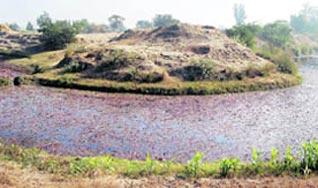Architecture
Researchers Discover Long-Lost Majithia Fort
by PERNEET SINGH
In what can turn out to be a major discovery, a conservation architect and a lecturer in the Architecture Department of Guru Nanak Dev University have located the site of a fort possibly dating back to 18th century and belonging to the famous Majithia clan in the nearby township of Majitha.
They believe it may be the ruins of the Majitha Fort.
There are clear land formations on the site, suggesting the
presence of four bastions of the fort surrounded by a double layer of
moat which runs parallel to the site in the typical shape of a fort.
Rawal Singh, a lecturer with Guru Nanak Dev University, and Rachanpuneet Singh, a
conservation architect, who had worked on the historic Gobindgarh Fort
in Amritsar, said they stumbled upon the fort while they were working on
a re-use plan for a police station in Majitha dating back to 1937.
"We
were working out the site plan on Google Earth when we zeroed in on a
fort-like outline on it. We visited this site around a month ago and
were amazed to see the prominent land forms on four corners of the land
located inside the moat," they averred.
They said
they would submit a report to the ASI in this regard in near future.
Another fact that hints towards the existence of the Majitha Fort at the
site is that the Imperial Gazetteer and Punjab revenue records say that
the Hudiara Drain originates from the Majitha Fort and, interestingly,
the drain is connected with the moat surrounding this site, suggesting
that once the fort existed here. The fort was purportedly built by the
ancestors of the great Sikh warrior, Hari Singh Nalwa.
Out of the
four bastions of the fort, the land formation around the southern
bastion is weak. The land inside the fort was found to be dug up at a
couple of points and one can easily see the bricks and lime plaster
running deep, which would have once formed the walls of the fort.
Rawal Singh said a D-shape outline inside the fort had a very dominating profile when seen through Google Earth, hinting the presence of a structure or its remnants beneath the ground. According to him, the fort dates back to the 18th century.
"The topology of this fort and Amritsar's Gobindgarh Fort is almost same. Also, both the forts had a double layer of moat. In terms of differences, the area of this fort is far less than that of Gobindgarh Fort," he said.
The duo felt that the fort had a
double layer of moat, which was used as a defence strategy as it may
have been more vulnerable to attacks.
At present, some families
are staying around the site and earning their livelihood by cultivating
singharas (water chestnut) in the moat. Simarjit Singh, who resides next
to the site, said: "Born and brought up here, I know this place as
Quila Dyal Singh and it was raised in the times of Desa Singh Majithia,
who belonged to the well-known and illustrious family of the Majithias
(of Majitha town). In my childhood, I have seen the ‘dyodhi' (entrance
gateway) of the fort close to its north bastion and a dilapidated
structure near its south bastion. However, with the passage of time, the
remains of the structure vanished as people took away the bricks."
The moat, Simarjit Singh said, was up to 18 to 20 feet deep at one point of time and he would often go fishing on his boat once it received rainwater from Alliwal and Jijeana villages. Now, the farmers having their land around the moat have installed water pumps which are the source of water in the moat. Even the houses situated on and around the site are made of the bricks taken out from the structures inside the fort.
Rachanpuneet Singh said these bricks, too,
would also be of great help in ascertaining the history of the fort. He
and Rawal Singh opined that once the site was restored by an agency like the
ASI, a tourist circuit may be designed with the site being the major
destination. They, however, said the facts and figures about the fort
need to be rechecked in conjunction with available history. The discovery is being
seen as one of the most important research projects of the Guru Nanak Dev University's Architecture Department.
On the other hand, District
Congress (rural) President Lali Singh Majithia, who currently owns the land
of the fort's site, said he could only recall some dilapidated
structures on the site during his early days. "Those structures only had
walls and no roof," he added.
Simarjeet Singh Majithia, son of former
minister Parkash Singh Majithia, who owns ancestral land near the site,
said he, too, had seen three or four structures on the site some time ago.
[Courtesy: The Tribune]
Conversation about this article
1: Gur Singh (Chicago, Illinois, U.S.A.), December 11, 2010, 8:22 AM.
A typical Punjabi scenario, where the owner does not know what he has.






